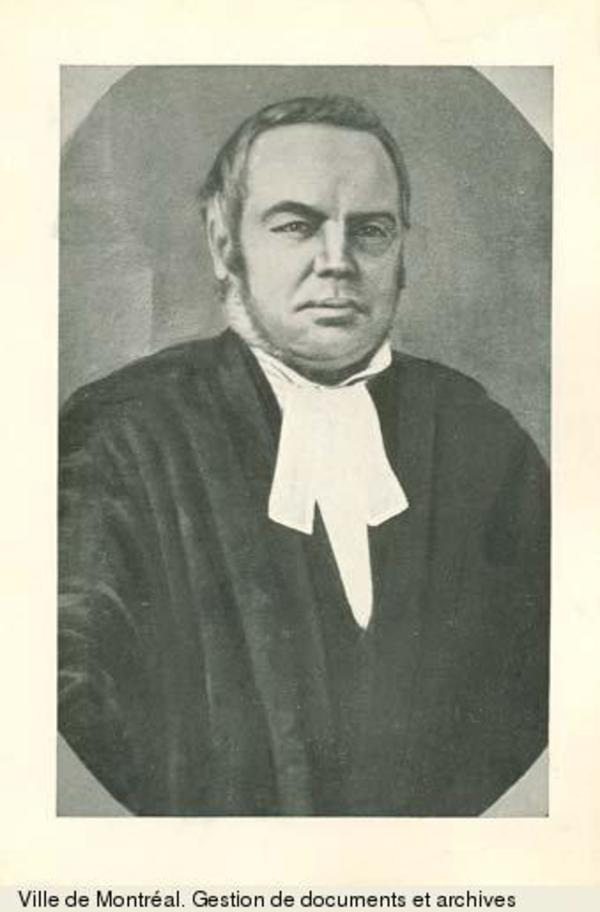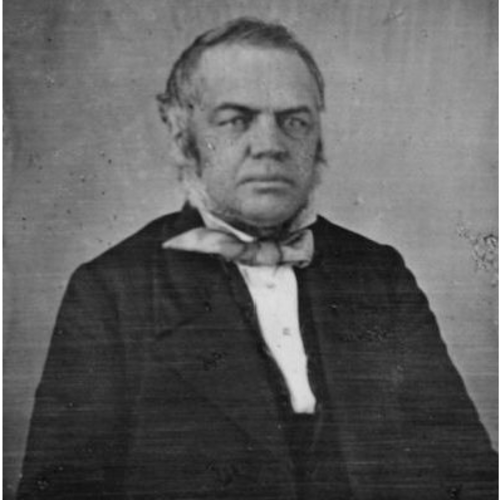
Source: Link
CHABOT, JEAN, lawyer, politician, and judge; b. 15 Oct. 1806 in Saint-Charles, near Quebec, son of Basile Chabot, a farmer, and Josephte Prévost; m. 1 July 1834 Hortense Hamel at Quebec; they had no children; d. there 31 May 1860.
Jean Chabot attended the Petit Séminaire de Québec from 1820 to 1828, and then from 26 Feb. 1829 studied law in the office of Elzéar Bédard*, who became the first mayor of Quebec in 1833. Chabot was called to the bar on 27 Feb. 1834 and quickly acquired a reputation as an eminent lawyer. In September 1843 he agreed to run in the by-election for the riding of the city of Quebec and was elected by acclamation. He was a supporter of Louis-Hippolyte La Fontaine* and, because the political conduct of Governor Sir Charles Theophilus Metcalfe* had resulted in the resignation of the government of La Fontaine and Robert Baldwin in November and the formation of a new one the following month by William Henry Draper* and Denis-Benjamin Viger*, Chabot had to settle for working in the opposition.
In the general election of 1844 he campaigned on the theme of ministerial responsibility and was returned by acclamation. Although not a great orator, he possessed real ability for parliamentary work; he was acknowledged especially to have the qualities of an excellent jurist and a gift for a biting reply. As member for the city of Quebec, he made a particular attempt, along with his colleagues Pierre-Joseph-Olivier Chauveau* and Thomas Cushing Aylwin*, to obtain the government’s cooperation in solving the problems overburdening his constituents. The major ones stemmed from the fires that raged in the city in May and June 1845. Although he supported some of the government initiatives, in particular the education act of 1845, Chabot was profoundly dissatisfied with the government. On 23 June 1847 he gave a dismal assessment, in the assembly, of its accomplishments, denouncing its favouritism towards Upper Canada and condemning as ineffective the measures passed to help the victims of the fires at Quebec.
In the same period Chabot took an active part in establishing the Society of St Vincent de Paul of Quebec [see Joseph Painchaud]. On 19 Nov. 1846 he was asked to be chairman of the Quebec conference of this philanthropic society, the first conference in the Province of Canada, and on 7 Feb. 1847 he was also appointed president of the Quebec council; he retained both responsibilities until 1850. Although he was aware of the problems facing the working class, he none the less did not approach them from the standpoint of social inequality. A man of his time and his milieu, Chabot appealed to charitable sentiments, at the same time holding that the poor were “for the most part depraved, idle, [and] provident,” as he stated in a letter to the citizens of Quebec signed on 31 Dec. 1847.
Perceived as a solid defender of the interests of Quebec, Chabot was again re-elected by acclamation in December 1847. This election, which led to the return to power of the coalition of La Fontaine and Baldwin in March 1848, also sent Louis-Joseph Papineau* back to the house. Papineau’s position on the union of the Canadas divided the liberals; for his part Chabot was firmly opposed to repeal of the union, a step Papineau was demanding, and reiterated his confidence in the reform policy of La Fontaine. Called upon to chair the public meeting held when Papineau came to Quebec on 11 May 1848, Chabot must have been aware of the enthusiasm of the French-speaking population there for the former Patriote chief, but he warned the meeting that despite his admiration for Papineau he was against repeal. This loyalty to La Fontaine’s party earned him appointment as commissioner of public works on 13 Dec. 1849, at the time of the reshuffle in the government due to the retirement of the speaker of the Legislative Council, René-Édouard Caron*. It was, however, largely through the influence of the secretary of the diocese of Quebec, Charles-Félix Cazeau*, his first cousin, that he was appointed. According to historian Jacques Monet, Cazeau proposed Chabot’s name to Joseph-Édouard Cauchon* and La Fontaine, who heeded his recommendations. Before assuming office, Chabot was obliged to seek a new mandate from his constituents, and had to campaign against annexationist Rouges and their candidate Joseph Légaré. With Cauchon’s support and Cazeau’s assistance this re-election posed no problem. But Chabot held office only a few months; an inveterate drunkard, he was obliged to resign in March 1850 after spending a night in jail in Toronto. Even before Chabot had been officially appointed, Lewis Thomas Drummond* had warned La Fontaine that he “possesses neither the personal dignity nor the political status that will be necessary,” and for his part Cauchon admitted to his leader on 15 December that he would need to have “a strong motive of public interest to support Chabot.”
Probably fearing the effect of these incidents on his popularity at Quebec, Chabot sought re-election in 1851 in Bellechasse and was successful. Following the speech from the throne he declared his support for the new government of Francis Hincks* and Augustin-Norbert Morin* and drew up a list of the things he expected it to accomplish: construction of roads to facilitate access to the new lands being opened up and thereby reduce emigration to the United States, abolition or at least reform of the Legislative Council, building of the Quebec–Halifax railway, codification of the laws, and above all abolition of seigneurial tenure to which he gave much attention. In September 1852, following the resignation of the commissioner of public works, John Young*, and the refusal of George-Étienne Cartier* to take the office, Chabot once again accepted it. In this capacity he would be closely involved in the first phase of expansion of the Canadian railway system, marked by the building of the Grand Trunk, although his role was primarily to back up the work of Hincks, the prime mover in these matters. From 20 Nov. 1852 to 26 Jan. 1855 Chabot sat as government representative on the board of directors of the Grand Trunk. He was also involved personally in various railway projects. In 1850 he was a director of the Quebec and Melbourne Railway, and in 1854 his name appeared on a petition presented to the assembly on behalf of the Northern Pacific Railroad. Chabot also took an interest in improving communications between Quebec and Lévis during the winter season, and in 1853 he managed to get a committee of the house to study the feasibility of using steam-powered ferries rather than an ice bridge.
In 1854 Jean Chabot stood as a candidate in both Bellechasse and the city of Quebec. He won easily in each and decided to represent Quebec. He kept his post as commissioner until January 1855, when Morin resigned and Sir Allan Napier MacNab* and Étienne-Paschal Taché* formed a new government. He was excluded from the cabinet but his services were retained from 19 June 1855 under the Seignorial Tenure Act as commissioner to draw up the land registers in each seigneury. Chabot remained member for Quebec until he was appointed on 20 Sept. 1856 as judge of the Superior Court with residence at Montreal. The following year his residence was transferred to Quebec, where he worked for the last three years of his life.
ANQ-Q, CE1-1, 1er juill. 1834, 2 juin 1860; CE2-4, 15 oct. 1806. ASQ, Fichier des anciens. PAC, RG 68, General index, 1841–67. Debates of the Legislative Assembly of United Canada (Abbott Gibbs et al.). Le Canadien, 18 sept. 1843; 2 oct. 1844; 15, 22 déc. 1847; 12 mai 1848; 14 déc. 1849; 28 janv. 1850; 24 sept. 1852; 10, 12, 24 juill. 1854; 1er juin 1860. Le Journal de Québec, 22 juill. 1854. F.-J. Audet, “Commissions d’avocats de la province de Québec, 1765 à 1849,” BRH, 39 (1933): 587; “Les législateurs du Bas-Canada.” Desjardins, Guide parl. I.-J. Deslauriers, Juges de la cour supérieure de 1849 à 1978 (s.l., 1978). Morgan, Sketches of celebrated Canadians. Quebec directory, 1847–60. P.-G. Roy, Les juges de la prov. de Québec . Monet, La première révolution tranquille. [Henri Têtu], Les noces d’or de la Société de Saint-Vincent de Paul à Québec, 1846–1896 (Québec, 1897). L.-P. Turcotte, Le Canada sous l’Union, 1841–1867 (2v., Québec, 1871–72).
Cite This Article
Pierre Poulin, “CHABOT, JEAN,” in Dictionary of Canadian Biography, vol. 8, University of Toronto/Université Laval, 2003–, accessed January 18, 2026, https://www.biographi.ca/en/bio/chabot_jean_8E.html.
The citation above shows the format for footnotes and endnotes according to the Chicago manual of style (16th edition). Information to be used in other citation formats:
| Permalink: | https://www.biographi.ca/en/bio/chabot_jean_8E.html |
| Author of Article: | Pierre Poulin |
| Title of Article: | CHABOT, JEAN |
| Publication Name: | Dictionary of Canadian Biography, vol. 8 |
| Publisher: | University of Toronto/Université Laval |
| Year of publication: | 1985 |
| Year of revision: | 1985 |
| Access Date: | January 18, 2026 |




